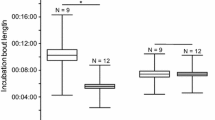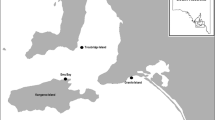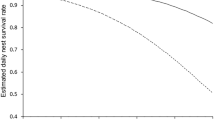Abstract
Parental behaviour and nest site are supposed to affect nest predation in birds. Few nest visits and high nest attentiveness are assumed to lead to low predation rates. Poorly concealed nests are thought to be more likely to be preyed upon than well concealed nests. Studies on the relationship between parental behaviour, nest site, and nest predation are rare and none have, so far, been conducted in the Afrotropics. We studied the effect of nest site, nest visitation rate, and nest attentiveness on the nest predation rate of the two tropical warblers Sylvia boehmi and Sylvia lugens in Kenya. Parental behaviour and predation on nests of 13 breeding pairs of both species were observed daily in two consecutive breeding seasons. In both species, parental activity at the nest was low [0.9 trips to the nest in 30 min during incubation, maximum 4.6 (S. boehmi) and 5.8 (S. lugens) trips to the nest in the nestling stage]. Predation rates in both species were high (Mayfield nest success 19.4 and 33.2%). Our analysis revealed only weak evidence for an effect of nest site, nest visitation rate, and nest attentiveness on the predation rate. It is suggested that smaller clutches of tropical in comparison to northern temperate birds result from lower feeding rates in tropical ecosystems with high predation rates (Skutch’s hypothesis). The underlying mechanism could not be proven in this study.




Similar content being viewed by others
References
Bibby CJ (1979) Breeding biology of the Dartford warbler Sylvia undata in England. Ibis 121:41–52
Blondel J, Catzeflis F, Perret P (1996) Molecular phylogeny and the historical biogeography of the warblers of the genus Sylvia (Aves). J Evol Biol 9:871–891
Böhning-Gaese K, Schuda MD, Helbig AJ (2003) Weak phylogenetic effects on ecological niches of Sylvia warblers. J Evol Biol 16:956–965
Cresswell W (1997) Nest predation: the relative effects of nest characteristics, clutch size and parental behaviour. Anim Behav 53:93–103
Doligez B, Clobert J (2003) Clutch size reduction as a response to increased nest predation rate in the collared flycatcher. Ecology 84:2582–2588
Farnsworth GL, Simons TR (1999) Factors affecting nesting success of wood thrushes in Great Smoky Mountains National Park. Auk 116:1075–1082
Gottfried BM, Thompson CF (1978) Experimental analysis of nest predation in an old-field habitat. Auk 95:304–312
Hayes PA, Robertson RJ (1989) The impact of male parental care on female Eastern Kingbird reproductive success. Wilson Bull 101:462–467
Leech SM, Leonard ML (1997) Begging and the risk of predation in nestling birds. Behav Ecol 8:644–646
Møller AP (1990) Nest predation selects for small nest size in the blackbird. Oikos 57:237–240
Martin TE (1992) Interaction of nest predation and food limitation in reproductive strategies. Curr Ornithol 9:163–197
Martin TE (1995) Avian life history evolution in relation to nest sites, nest predation, and food. Ecol Monogr 65:101–127
Martin TE (1996) Life history evolution in tropical and south temperate birds: what do we really know? J Avian Biol 27:263–272
Martin TE, Roper JJ (1988) Nest predation and nest-site selection of a western population of the Hermit Thrush. Condor 90:51–57
Martin TE, Martin PR, Olson CR, Heidinger BJ, Fontaine JJ (2000a) Parental care and clutch sizes in North and South American birds. Science 287:1482–1485
Martin TE, Scott J, Menge C (2000b) Nest predation increases with parental activity: separating nest site and parental activity effects. Proc R Soc Lond B 267:2287–2293
McCleery RH, Clobert J, Julliard R, Perrins CM (1996) Nest predation and delayed cost of reproduction in the great tit. J Anim Ecol 65:96–104
Montgomerie RD, Weatherhead PJ (1988) Risks and rewards of nest defence by parent birds. Q Rev Biol 63:167–187
Rabenold KN (1984) Cooperative enhancement of reproductive success in tropical wren societies. Ecology 65:871–885
Redondo T, Castro F (1992) The increase in risk of predation with begging activity in broods of Magpies Pica pica. Ibis 134:180–187
Ricklefs RE (1969) An analysis of nesting mortality in birds. Smithson Contrib Zool 9:1–48
Roper JJ, Goldstein RR (1997) A test of the Skutch hypothesis: does activity at nests increase nest predation risk? J Avian Biol 28:111–116
Schaefer H-C, Eshiamwata GW, Munyekenye FB, Böhning-Gaese K (2004) Life-history of two African Sylvia warblers: low annual fecundity and long post-fledging care. Ibis 146:427–437
Shirihai H, Gargallo G, Helbig AJ (2001) Sylvia warblers: identification, taxonomy and phylogeny of the genus Sylvia. Helm, London
Sibley CG, Ahlquist JE (1990) Phylogeny and classification of birds: a study in molecular evolution. Yale University Press, New Haven
Skutch AF (1949) Do tropical birds rear as many young as they can nourish? Ibis 91:430–455
Skutch AF (1985) Clutch size, nesting success, and predation on nests of Neotropical birds, reviewed. Ornithol Monogr 36:575–594
Slagsvold T (1982) Clutch size variation in passerine birds: the nest predation hypothesis. Oecologia 54:159–169
Slagsvold T (1984) Clutch size variation in birds in relation to nest predation: on the cost of reproduction. J Anim Ecol 53:945–953
Weidinger K (2002) Interactive effects of concealment, parental behaviour and predators on the survival of open passerine nests. J Anim Ecol 71:424–437
Willis EO (1973) Survival rates for visited and unvisited nests of bicolored antbirds. Auk 90:263–267
Wilson GR, Brittingham MC, Goodrich LJ (1998) How well do artificial nests estimate success of real nests? Condor 100:357–364
Acknowledgements
We thank Mr. Peter Barclay, the owner of Madrugada Farm, his family and staff, as well as the staff of National Museums of Kenya’s Olorgesailie prehistoric site for their support. We also thank Leon Bennun, Alfred Owino and many others from the Department of Ornithology, National Museums of Kenya for the good cooperation. The paper discussion group at the Dep. of Ecology, University of Mainz, gave helpful comments on the manuscript. The project was financed by Deutsche Forschungsgemeinschaft (Bo 1221/9–1). Fieldwork in Kenya was conducted under research license MOEST 13/001/29C 178 and complied with current Kenyan laws.
Author information
Authors and Affiliations
Corresponding author
Additional information
Communicated by F. Bairlein
Rights and permissions
About this article
Cite this article
Schaefer, HC., Eshiamwata, G.W., Munyekenye, F.B. et al. Nest predation is little affected by parental behaviour and nest site in two African Sylvia warblers. J Ornithol 146, 167–175 (2005). https://doi.org/10.1007/s10336-005-0076-7
Received:
Revised:
Accepted:
Published:
Issue Date:
DOI: https://doi.org/10.1007/s10336-005-0076-7




